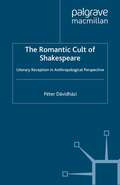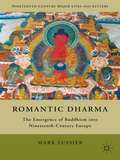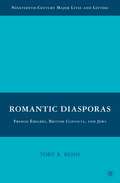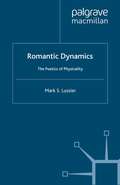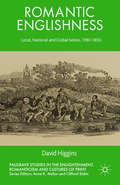- Table View
- List View
Romantic Climates: Literature and Science in an Age of Catastrophe
by Anne Collett Olivia MurphyThis book seeks to uncover how today’s ideas about climate and catastrophe have been formed by the thinking of Romantic poets, novelists and scientists, and how these same ideas might once more be harnessed to assist us in the new climate challenges facing us in the present. The global climate disaster following Mt Tambora’s eruption in 1815 – the ‘Year without a Summer’ – is a starting point from which to reconsider both how the Romantics responded to the changing climates of their day, and to think about how these climatic events shaped the development of Romanticism itself. As the contributions to this volume demonstrate, climate is an inescapable aspect of Romantic writing and thinking. Ideologies and experiences of climate inform everything from scientific writing to lyric poetry and novels. The ‘Diodati circle’ that assembled in Geneva in 1816 – Lord Byron, Percy and Mary Shelley, John Polidori and John Cam Hobhouse and the gothic novelist MG ‘Monk’ Lewis – is synonymous with the literature of that dreary, uncanny season. Essays in this collection also consider the work of Jane Austen, John Keats and William Wordsworth, along with less well-known figures such as the scientist Luke Howard, and later responses to Romantic climates by John Ruskin and Virginia Woolf.
The Romantic Conception of Life: Science and Philosophy in the Age of Goethe (Science and Its Conceptual Foundations series)
by Robert J. Richards"All art should become science and all science art; poetry and philosophy should be made one." Friedrich Schlegel's words perfectly capture the project of the German Romantics, who believed that the aesthetic approaches of art and literature could reveal patterns and meaning in nature that couldn't be uncovered through rationalistic philosophy and science alone. In this wide-ranging work, Robert J. Richards shows how the Romantic conception of the world influenced (and was influenced by) both the lives of the people who held it and the development of nineteenth-century science. Integrating Romantic literature, science, and philosophy with an intimate knowledge of the individuals involved—from Goethe and the brothers Schlegel to Humboldt and Friedrich and Caroline Schelling—Richards demonstrates how their tempestuous lives shaped their ideas as profoundly as their intellectual and cultural heritage. He focuses especially on how Romantic concepts of the self, as well as aesthetic and moral considerations—all tempered by personal relationships—altered scientific representations of nature. Although historians have long considered Romanticism at best a minor tributary to scientific thought, Richards moves it to the center of the main currents of nineteenth-century biology, culminating in the conception of nature that underlies Darwin's evolutionary theory. Uniting the personal and poetic aspects of philosophy and science in a way that the German Romantics themselves would have honored, The Romantic Conception of Life alters how we look at Romanticism and nineteenth-century biology.
The Romantic Conception of Life: Science and Philosophy in the Age of Goethe (Science and Its Conceptual Foundations series)
by Robert J. Richards"All art should become science and all science art; poetry and philosophy should be made one." Friedrich Schlegel's words perfectly capture the project of the German Romantics, who believed that the aesthetic approaches of art and literature could reveal patterns and meaning in nature that couldn't be uncovered through rationalistic philosophy and science alone. In this wide-ranging work, Robert J. Richards shows how the Romantic conception of the world influenced (and was influenced by) both the lives of the people who held it and the development of nineteenth-century science. Integrating Romantic literature, science, and philosophy with an intimate knowledge of the individuals involved—from Goethe and the brothers Schlegel to Humboldt and Friedrich and Caroline Schelling—Richards demonstrates how their tempestuous lives shaped their ideas as profoundly as their intellectual and cultural heritage. He focuses especially on how Romantic concepts of the self, as well as aesthetic and moral considerations—all tempered by personal relationships—altered scientific representations of nature. Although historians have long considered Romanticism at best a minor tributary to scientific thought, Richards moves it to the center of the main currents of nineteenth-century biology, culminating in the conception of nature that underlies Darwin's evolutionary theory. Uniting the personal and poetic aspects of philosophy and science in a way that the German Romantics themselves would have honored, The Romantic Conception of Life alters how we look at Romanticism and nineteenth-century biology.
The Romantic Conception of Life: Science and Philosophy in the Age of Goethe (Science and Its Conceptual Foundations series)
by Robert J. Richards"All art should become science and all science art; poetry and philosophy should be made one." Friedrich Schlegel's words perfectly capture the project of the German Romantics, who believed that the aesthetic approaches of art and literature could reveal patterns and meaning in nature that couldn't be uncovered through rationalistic philosophy and science alone. In this wide-ranging work, Robert J. Richards shows how the Romantic conception of the world influenced (and was influenced by) both the lives of the people who held it and the development of nineteenth-century science. Integrating Romantic literature, science, and philosophy with an intimate knowledge of the individuals involved—from Goethe and the brothers Schlegel to Humboldt and Friedrich and Caroline Schelling—Richards demonstrates how their tempestuous lives shaped their ideas as profoundly as their intellectual and cultural heritage. He focuses especially on how Romantic concepts of the self, as well as aesthetic and moral considerations—all tempered by personal relationships—altered scientific representations of nature. Although historians have long considered Romanticism at best a minor tributary to scientific thought, Richards moves it to the center of the main currents of nineteenth-century biology, culminating in the conception of nature that underlies Darwin's evolutionary theory. Uniting the personal and poetic aspects of philosophy and science in a way that the German Romantics themselves would have honored, The Romantic Conception of Life alters how we look at Romanticism and nineteenth-century biology.
The Romantic Conception of Life: Science and Philosophy in the Age of Goethe (Science and Its Conceptual Foundations series)
by Robert J. Richards"All art should become science and all science art; poetry and philosophy should be made one." Friedrich Schlegel's words perfectly capture the project of the German Romantics, who believed that the aesthetic approaches of art and literature could reveal patterns and meaning in nature that couldn't be uncovered through rationalistic philosophy and science alone. In this wide-ranging work, Robert J. Richards shows how the Romantic conception of the world influenced (and was influenced by) both the lives of the people who held it and the development of nineteenth-century science. Integrating Romantic literature, science, and philosophy with an intimate knowledge of the individuals involved—from Goethe and the brothers Schlegel to Humboldt and Friedrich and Caroline Schelling—Richards demonstrates how their tempestuous lives shaped their ideas as profoundly as their intellectual and cultural heritage. He focuses especially on how Romantic concepts of the self, as well as aesthetic and moral considerations—all tempered by personal relationships—altered scientific representations of nature. Although historians have long considered Romanticism at best a minor tributary to scientific thought, Richards moves it to the center of the main currents of nineteenth-century biology, culminating in the conception of nature that underlies Darwin's evolutionary theory. Uniting the personal and poetic aspects of philosophy and science in a way that the German Romantics themselves would have honored, The Romantic Conception of Life alters how we look at Romanticism and nineteenth-century biology.
The Romantic Conception of Life: Science and Philosophy in the Age of Goethe (Science and Its Conceptual Foundations series)
by Robert J. Richards"All art should become science and all science art; poetry and philosophy should be made one." Friedrich Schlegel's words perfectly capture the project of the German Romantics, who believed that the aesthetic approaches of art and literature could reveal patterns and meaning in nature that couldn't be uncovered through rationalistic philosophy and science alone. In this wide-ranging work, Robert J. Richards shows how the Romantic conception of the world influenced (and was influenced by) both the lives of the people who held it and the development of nineteenth-century science. Integrating Romantic literature, science, and philosophy with an intimate knowledge of the individuals involved—from Goethe and the brothers Schlegel to Humboldt and Friedrich and Caroline Schelling—Richards demonstrates how their tempestuous lives shaped their ideas as profoundly as their intellectual and cultural heritage. He focuses especially on how Romantic concepts of the self, as well as aesthetic and moral considerations—all tempered by personal relationships—altered scientific representations of nature. Although historians have long considered Romanticism at best a minor tributary to scientific thought, Richards moves it to the center of the main currents of nineteenth-century biology, culminating in the conception of nature that underlies Darwin's evolutionary theory. Uniting the personal and poetic aspects of philosophy and science in a way that the German Romantics themselves would have honored, The Romantic Conception of Life alters how we look at Romanticism and nineteenth-century biology.
The Romantic Conception of Life: Science and Philosophy in the Age of Goethe (Science and Its Conceptual Foundations series)
by Robert J. Richards"All art should become science and all science art; poetry and philosophy should be made one." Friedrich Schlegel's words perfectly capture the project of the German Romantics, who believed that the aesthetic approaches of art and literature could reveal patterns and meaning in nature that couldn't be uncovered through rationalistic philosophy and science alone. In this wide-ranging work, Robert J. Richards shows how the Romantic conception of the world influenced (and was influenced by) both the lives of the people who held it and the development of nineteenth-century science. Integrating Romantic literature, science, and philosophy with an intimate knowledge of the individuals involved—from Goethe and the brothers Schlegel to Humboldt and Friedrich and Caroline Schelling—Richards demonstrates how their tempestuous lives shaped their ideas as profoundly as their intellectual and cultural heritage. He focuses especially on how Romantic concepts of the self, as well as aesthetic and moral considerations—all tempered by personal relationships—altered scientific representations of nature. Although historians have long considered Romanticism at best a minor tributary to scientific thought, Richards moves it to the center of the main currents of nineteenth-century biology, culminating in the conception of nature that underlies Darwin's evolutionary theory. Uniting the personal and poetic aspects of philosophy and science in a way that the German Romantics themselves would have honored, The Romantic Conception of Life alters how we look at Romanticism and nineteenth-century biology.
Romantic Consciousness: Blake to Mary Shelley
by J. BeerRevolutionary thinking at the end of the Eighteenth century prompted major English writers to probe the riddle of human consciousness and the ways in which it might differ from 'Being' in a divine or universal sense. In the first of two studies, John Beer traces this question in writings by Blake, Coleridge and Wordsworth, and the impact of their ideas on successors such as Keats, De Quincey, Byron and the Shelleys. Relevance to later figures such as the Cambridge Apostles and Tennyson is also discussed.
Romantic Cosmopolitanism (Palgrave Studies in the Enlightenment, Romanticism and Cultures of Print)
by E. WohlgemutRomantic Cosmopolitanism shows how cosmopolitanism in the early nineteenth century offers a non-unified formulation of the nation that stands in contrast to more unified models such as Edmund Burke's which found nationality in, among other things, language, history, blood and geography.
The Romantic Cult of Shakespeare: Literary Reception in Anthropological Perspective (Romanticism in Perspective:Texts, Cultures, Histories)
by P. DavidhaziFocusing on England, Hungary and on some other European countries, the book explores the latent religious patterns in the appropriation of Shakespeare from the 1769 Stratford Jubilee to the tercentenary of Shakespeare's birth in 1864. It shows how the Shakespeare cult used quasi-religious (verbal and ritual) means of reverence, how it made use of some romantic notions, and how the ensuing quasi-transcendental authority was utilized for political purposes. The book suggests a theoretical framework and a comprehensive anthropological context for the interpretation of literature.
Romantic Dharma: The Emergence of Buddhism into Nineteenth-Century Europe (Nineteenth-Century Major Lives and Letters)
by M. LussierRomantic Dharma maps the emergence of Buddhism into European consciousness during the first half of the nineteenth century, probes the shared ethical and intellectual commitments embedded in Buddhist and Romantic thought, and proposes potential ways by which those insights translate into contemporary critical and pedagogical practices.
Romantic Diasporas: French Émigrés, British Convicts, and Jews (Nineteenth-Century Major Lives and Letters)
by T. BenisRomantic Diasporasexamines exile in the Romantic period fromthe different perspectives of French émigrés in England, British convicts transported to Australia, and Jews in their perennial diaspora.
Romantic Dynamics: The Poetics of Physicality (Romanticism in Perspective:Texts, Cultures, Histories)
by M. LussierRomantic Dynamics creatively collides English poetry with a wide range of exotic concepts associated with the 'new physics' of relativity and quantum to uncover their shared concerns for indeterminacy, uncertainty, relativity, and complexity in a chaotic universe. This interdisciplinary work traces the elaboration of dynamical models of cosmos and consciousness in works by Blake, Byron, Coleridge, the Shelleys and Wordsworth, finding in those works an exploration of the interpenetration of psyche and phenomena. This model, the author argues, establishes a new metaphoric terrain liberated from the classical mechanics of Newtonian thought and more easily traversed with models articulated by Bohr, Einstein and Hawking.
Romantic Echoes in the Victorian Era (The Nineteenth Century Series)
by Andrew RadfordIn tracing those deliberate and accidental Romantic echoes that reverberate through the Victorian age into the beginning of the twentieth century, this collection acknowledges that the Victorians decided for themselves how to define what is 'Romantic'. The essays explore the extent to which Victorianism can be distinguished from its Romantic precursors, or whether it is possible to conceive of Romanticism without the influence of these Victorian definitions. Romantic Echoes in the Victorian Era reassesses Romantic literature's immediate cultural and literary legacy in the late nineteenth century, showing how the Victorian writings of Matthew Arnold, Wilkie Collins, the Brontës, the Brownings, Elizabeth Gaskell, Charles Dickens, Gerard Manley Hopkins, Thomas Hardy, and the Rossettis were instrumental in shaping Romanticism as a cultural phenomenon. Many of these Victorian writers found in the biographical, literary, and historical models of Chatterton, Coleridge, Byron, Shelley, Keats, and Wordsworth touchstones for reappraising their own creative potential and artistic identity. Whether the Victorians affirmed or revolted against the Romanticism of their early years, their attitudes towards Romantic values enriched and intensified the personal, creative, and social dilemmas described in their art. Taken together, the essays in this collection reflect on current critical dialogues about literary periodisation and contribute to our understanding of how these contemporary debates stem from Romanticism's inception in the Victorian age.
Romantic Echoes in the Victorian Era (The Nineteenth Century Series)
by Andrew RadfordIn tracing those deliberate and accidental Romantic echoes that reverberate through the Victorian age into the beginning of the twentieth century, this collection acknowledges that the Victorians decided for themselves how to define what is 'Romantic'. The essays explore the extent to which Victorianism can be distinguished from its Romantic precursors, or whether it is possible to conceive of Romanticism without the influence of these Victorian definitions. Romantic Echoes in the Victorian Era reassesses Romantic literature's immediate cultural and literary legacy in the late nineteenth century, showing how the Victorian writings of Matthew Arnold, Wilkie Collins, the Brontës, the Brownings, Elizabeth Gaskell, Charles Dickens, Gerard Manley Hopkins, Thomas Hardy, and the Rossettis were instrumental in shaping Romanticism as a cultural phenomenon. Many of these Victorian writers found in the biographical, literary, and historical models of Chatterton, Coleridge, Byron, Shelley, Keats, and Wordsworth touchstones for reappraising their own creative potential and artistic identity. Whether the Victorians affirmed or revolted against the Romanticism of their early years, their attitudes towards Romantic values enriched and intensified the personal, creative, and social dilemmas described in their art. Taken together, the essays in this collection reflect on current critical dialogues about literary periodisation and contribute to our understanding of how these contemporary debates stem from Romanticism's inception in the Victorian age.
Romantic Education in Nineteenth-Century American Literature: National and Transatlantic Contexts (Routledge Studies in Romanticism)
by Monika M. Elbert Lesley GinsbergAmerican publishing in the long nineteenth century was flooded with readers, primers, teaching-training manuals, children’s literature, and popular periodicals aimed at families. These publications attest to an abiding faith in the power of pedagogy that has its roots in transatlantic Romantic conceptions of pedagogy and literacy. The essays in this collection examine the on-going influence of Romanticism in the long nineteenth century on American thinking about education, as depicted in literary texts, in historical accounts of classroom dynamics, or in pedagogical treatises. They also point out that though this influence was generally progressive, the benefits of this social change did not reach many parts of American society. This book is therefore an important reference for scholars of Romantic studies, American studies, historical pedagogy and education.
Romantic Education in Nineteenth-Century American Literature: National and Transatlantic Contexts (Routledge Studies in Romanticism)
by Monika M. Elbert Lesley GinsbergAmerican publishing in the long nineteenth century was flooded with readers, primers, teaching-training manuals, children’s literature, and popular periodicals aimed at families. These publications attest to an abiding faith in the power of pedagogy that has its roots in transatlantic Romantic conceptions of pedagogy and literacy. The essays in this collection examine the on-going influence of Romanticism in the long nineteenth century on American thinking about education, as depicted in literary texts, in historical accounts of classroom dynamics, or in pedagogical treatises. They also point out that though this influence was generally progressive, the benefits of this social change did not reach many parts of American society. This book is therefore an important reference for scholars of Romantic studies, American studies, historical pedagogy and education.
Romantic Englishness: Local, National and Global Selves, 1780-1850 (Palgrave Studies in the Enlightenment, Romanticism and Cultures of Print)
by D. HigginsRomantic Englishness investigates how narratives of localised selfhood in English Romantic writing are produced in relation to national and transnational formations. This book focuses on autobiographical texts by authors such as John Clare, Samuel Taylor Coleridge, William Hazlitt, Charles Lamb, and William Wordsworth.
Romantic Feuds: Transcending the 'Age of Personality' (The Nineteenth Century Series)
by Kim WheatleyRomantic writers such as Robert Southey and Samuel Taylor Coleridge aspired to rise above the so-called 'age of personality,' a new culture of politicized print gossip and personal attacks. Nevertheless, Southey, Coleridge, and other Romantic-era figures such as Leigh Hunt, William Hazlitt, Sydney Owenson, and the explorer John Ross became enmeshed in lively feuds with the major periodicals of the day, the Edinburgh Review and the Quarterly Review. Kim Wheatley focuses on feuds from the second and third decades of the nineteenth century, suggesting that by this time the vituperative rhetoric of the Edinburgh and the Quarterly had developed into what Coleridge called 'a habit of malignity.' Attending to the formal strategies of the reviewers' surprisingly creative prose, she traces how her chosen feuds take on lives of their own, branching off into other print media, including the weekly press and monthly magazines. Ultimately, Wheatley shows, these hostile exchanges incorporated literary genres and Romantic themes such as the idealized poetic self, the power of the supernatural, and the quest for the sublime. By turning episodes of print warfare into stories of transfiguration, the feuds thus unexpectedly contributed to the emergence of Romanticism.
Romantic Feuds: Transcending the 'Age of Personality' (The Nineteenth Century Series)
by Kim WheatleyRomantic writers such as Robert Southey and Samuel Taylor Coleridge aspired to rise above the so-called 'age of personality,' a new culture of politicized print gossip and personal attacks. Nevertheless, Southey, Coleridge, and other Romantic-era figures such as Leigh Hunt, William Hazlitt, Sydney Owenson, and the explorer John Ross became enmeshed in lively feuds with the major periodicals of the day, the Edinburgh Review and the Quarterly Review. Kim Wheatley focuses on feuds from the second and third decades of the nineteenth century, suggesting that by this time the vituperative rhetoric of the Edinburgh and the Quarterly had developed into what Coleridge called 'a habit of malignity.' Attending to the formal strategies of the reviewers' surprisingly creative prose, she traces how her chosen feuds take on lives of their own, branching off into other print media, including the weekly press and monthly magazines. Ultimately, Wheatley shows, these hostile exchanges incorporated literary genres and Romantic themes such as the idealized poetic self, the power of the supernatural, and the quest for the sublime. By turning episodes of print warfare into stories of transfiguration, the feuds thus unexpectedly contributed to the emergence of Romanticism.
Romantic Fiat: Demystification and Enchantment in Lyric Poetry
by E. LindstromIn the Romantic period's economics of 'fiat' money the legacy of romanticism involves absolutist gestures of verbal fiat. Focused on William Wordsworth, but in constant range of his poet-successors and modern critics, Romantic Fiat presents an argument for a double romantic signature of 'let there be' and 'let be.'
The Romantic Fiction Of Mills & Boon, 1909-1995 (Women's and Gender History)
by Dixon, Jay Jay Dixon.This study to analyzes romantic fiction's depiction of women as part of the broader history of ideas about women.; Given the success of the Mills & Boon romance, their portrayal of subjects like sex, love, marriage, class, motherhood and femineity are important cultural barometers and make interesting study.; The author shows how all these themes have an historical trajectory and how these novels have come to reflect feminist concerns.; Based on a study of over 1000 Mills & Boon romances the book provides analysis of plot types and shows how these have changed in response to women's own changing position within society.
The Romantic Fiction Of Mills & Boon, 1909-1995 (Women's and Gender History)
by Dixon, Jay Jay Dixon.This study to analyzes romantic fiction's depiction of women as part of the broader history of ideas about women.; Given the success of the Mills & Boon romance, their portrayal of subjects like sex, love, marriage, class, motherhood and femineity are important cultural barometers and make interesting study.; The author shows how all these themes have an historical trajectory and how these novels have come to reflect feminist concerns.; Based on a study of over 1000 Mills & Boon romances the book provides analysis of plot types and shows how these have changed in response to women's own changing position within society.
The Romantic Fragment Poem: A Critique of a Form
by Marjorie LevinsonThe fragment poem, long regarded as a peculiarly Romantic phenomenon, has never been examined outside the context of thematic and biographical criticism. By submitting the unfinished poems of the English Romantics to both a genetic investigation and a reception study, Marjorie Levinson defines the fragment's formal character at various moments in its historical career. She suggests that the formal determinancy of these works, hence their expressive or semantic affinities, is a function of historical conditions and projections.The English Romantic fragment poems share not so much a particular mode of production as a myth of production. Levinson pries apart these two dimensions and analyzes each independently to consider their relationship. By reconstructing the contemporary reception of such works as Wordsworth's "Nutting," Coleridge's "Christabel" and "Kubla Khan," Shelley's "Julian and Maddalo," and Keats's Hyperion fragments, and juxtaposing this model against dominant twentieth-century critical paradigms, Levinson discriminates layers, phases, and kinds of intentionality in the poems and considers the ideological implications of this diversity.This study is the first to investigate the English Romantic fragment poem by identifying the assumptions -- contemporary and belated -- that govern interpretative procedures. In a substantial summary chapter, Levinson reflects upon the meaning and effects of these assumptions with respect to the facts and fictions of literary production in the period and to the processes of canon formation.Originally published in 1986.A UNC Press Enduring Edition -- UNC Press Enduring Editions use the latest in digital technology to make available again books from our distinguished backlist that were previously out of print. These editions are published unaltered from the original, and are presented in affordable paperback formats, bringing readers both historical and cultural value.
Romantic Friendship in Victorian Literature
by Carolyn W. OultonCarolyn Oulton recovers the strategies nineteenth-century authors used to justify the ideal of same-sex romantic friendship and the anxieties these strategies reveal. Informed by recent insights into the erotic potential of such relationships, but focused on romantic friendship as an independent and fully formulated ideal, Oulton departs from other critics who view romantic friendship as either nebulous and culturally naive or an invocation of homoerotic responsiveness. By considering both male and female friendships, Oulton uncovers surprising parallels between them in novels and poetry by authors such as Dickens, Tennyson, Disraeli, Charlotte Brontë, and Braddon. Oulton also examines conduct manuals, periodicals, and religious treatises, tracing developments from mid-century to the fin de siècle, when romantic friendship first came under serious attack. Her book is a persuasive challenge to those who view mid-Victorian England, existing in a state of blissful pre-Freudian innocence, as unproblematically accommodating of passionate same-sex relationships.




